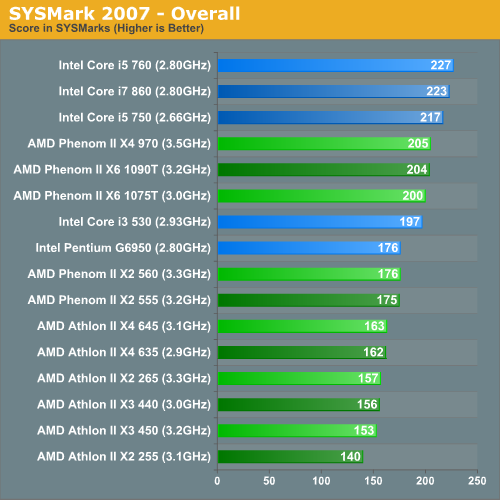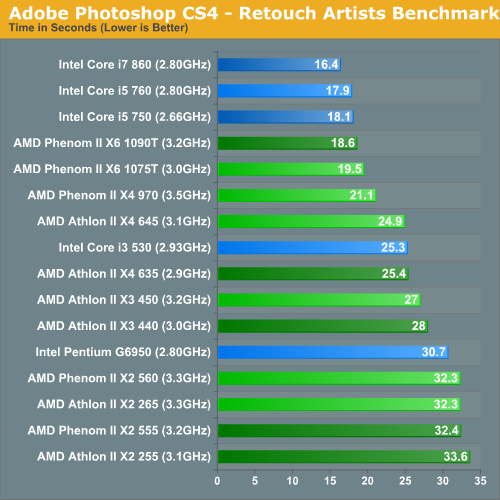AMD's Fall Refresh: New Phenom II and Athlon II CPUs Balance Price and Performance
by Anand Lal Shimpi on September 21, 2010 2:52 AM EST- Posted in
- CPUs
- AMD
- Phenom II X6
- Athlon II
SYSMark 2007 Performance
Our journey starts with SYSMark 2007, the only all-encompassing performance suite in our review today. The idea here is simple: one benchmark to indicate the overall performance of your machine.

Let's go down the matchups shall we? The Phenom II X4 970 BE is competitive with the Core i5 750. Intel manages a 5.9% performance advantage in this comparison, but as I mentioned earlier the two chips will trade blows across much of our benchmark suite.
The Phenom II X6 1075T doesn't have a direct competitor but here it does worse than the cheaper Core i5 750. SYSMark is mostly a test of good dual-core performance and as a result Intel's turbo does more for performance here than AMD's 2-extra cores. It's a valid scenario to keep in mind as the number of applications that can stress all 6 cores are limited. Although when you're running one, there's generally no substitute for more cores.
As I mentioned in the introduction, the Phenom II X2 560 will easily lose to the Core i3 530 as the graph shows above. The same is true for the Athlon II X4 645. The chip gives you four cores at a very competitive price, but in a test that primarily stresses two cores the 645 doesn't get a chance to run.
The Athlon II X3 450 vs. Pentium G6950 matchup begins in Intel's favor, however this is the one and only time in our review that you'll see this happen.
Adobe Photoshop CS4 Performance
To measure performance under Photoshop CS4 we turn to the Retouch Artists’ Speed Test. The test does basic photo editing; there are a couple of color space conversions, many layer creations, color curve adjustment, image and canvas size adjustment, unsharp mask, and finally a gaussian blur performed on the entire image.
The whole process is timed and thanks to the use of Intel's X25-M SSD as our test bed hard drive, performance is far more predictable than back when we used to test on mechanical disks.
Time is reported in seconds and the lower numbers mean better performance. The test is multithreaded and can hit all four cores in a quad-core machine.

Our Photoshop benchmark has traditionally favored Intel's architectures, which is definitely visible when you look at the Phenom II X6 1075T and Phenom II X4 970 BE above. The Athlon II X4 645 does slightly better than the Core i3 530 (effectively on-par with the 540), while the Athlon II X3 450 does noticeably better than the Pentium G6950. You can also see why I'm not really interested in the dual-core parts. They perform well, but that third core does come in handy for very little added cost.










98 Comments
View All Comments
KikassAssassin - Tuesday, September 21, 2010 - link
On page 1: "The Core i3 540 is priced similarly but you only get two cores, and no Hyper Threading to bridge the gap."The Core i3 does have HyperThreading. The only Clarkdale CPU without HyperThreading is the Pentium G6950.
quiksilvr - Tuesday, September 21, 2010 - link
One issue I'm having is the weird color scheme in your graphs. Just make all AMDs green and all Intel's blue. Stop mixing and matching randomly. It makes the colors useless and misleading.Anand Lal Shimpi - Tuesday, September 21, 2010 - link
I only highlighted the new chips we were focusing on. I debated doing it the other way (AMD green, Intel blue) but figured the focus should be on the new chips. I can understand the confusion though. I've updated the graphs to reflect green for AMD and blue for Intel, if everyone is ok with it I'll keep it :)Take care,
Anand
quiksilvr - Tuesday, September 21, 2010 - link
Much appreciated! A suggestion could be this to differentiate between old and new:Light Blue for New Intels
Dark and less saturated Blue for Old Intels
Light Green for New AMDs
Dark and less saturated Green for Old AMDs
vol7ron - Tuesday, September 21, 2010 - link
This sounds good to me - just don't make the contrast too different that we have to look at 4 different colors. The greens should be close enough in spectrum that they can be distinguished but close to the same hue (same for the blue).That way looking at a glance your brain can quickly compare overall AMD vs Intel, but then giving it more consideration you can tell what's new/old.
KikassAssassin - Tuesday, September 21, 2010 - link
This sounds like the best option to me.JarredWalton - Tuesday, September 21, 2010 - link
I've updated the graphs to use the dark/light colors, though I'm not sure how "new" some of the Intel parts are. Anyway, at least there's a bit of separation to make things "visible".quiksilvr - Tuesday, September 21, 2010 - link
You guys are awesome! You're like, one of the busiest gadget sites on the web yet you took the time to read my suggestion and actually implement it!High five!
(turns off Adblock for Anandtech.com)
vol7ron - Wednesday, September 22, 2010 - link
i think the light green is a little too light, but much betterfoundchild1 - Tuesday, September 21, 2010 - link
Have you guys ever thought about placing the prices of the chips in the benchmark tables for easy price reference? Perhaps just to the right of the benchmarks?Just a suggestion!
Thanks for this update as well, AMD is starting to regain my interest.